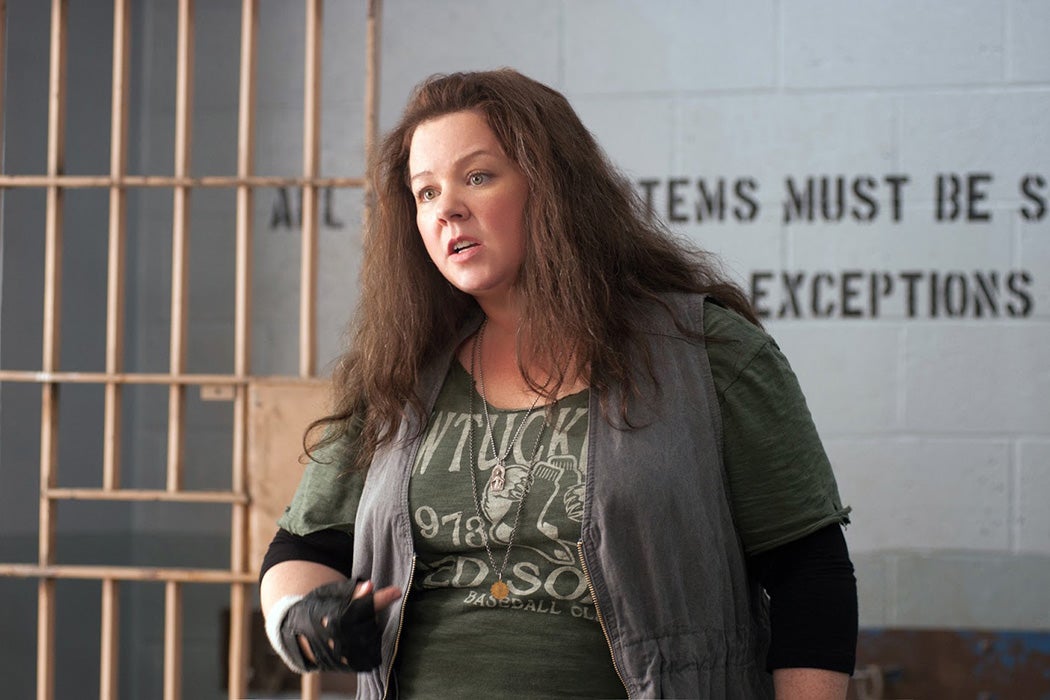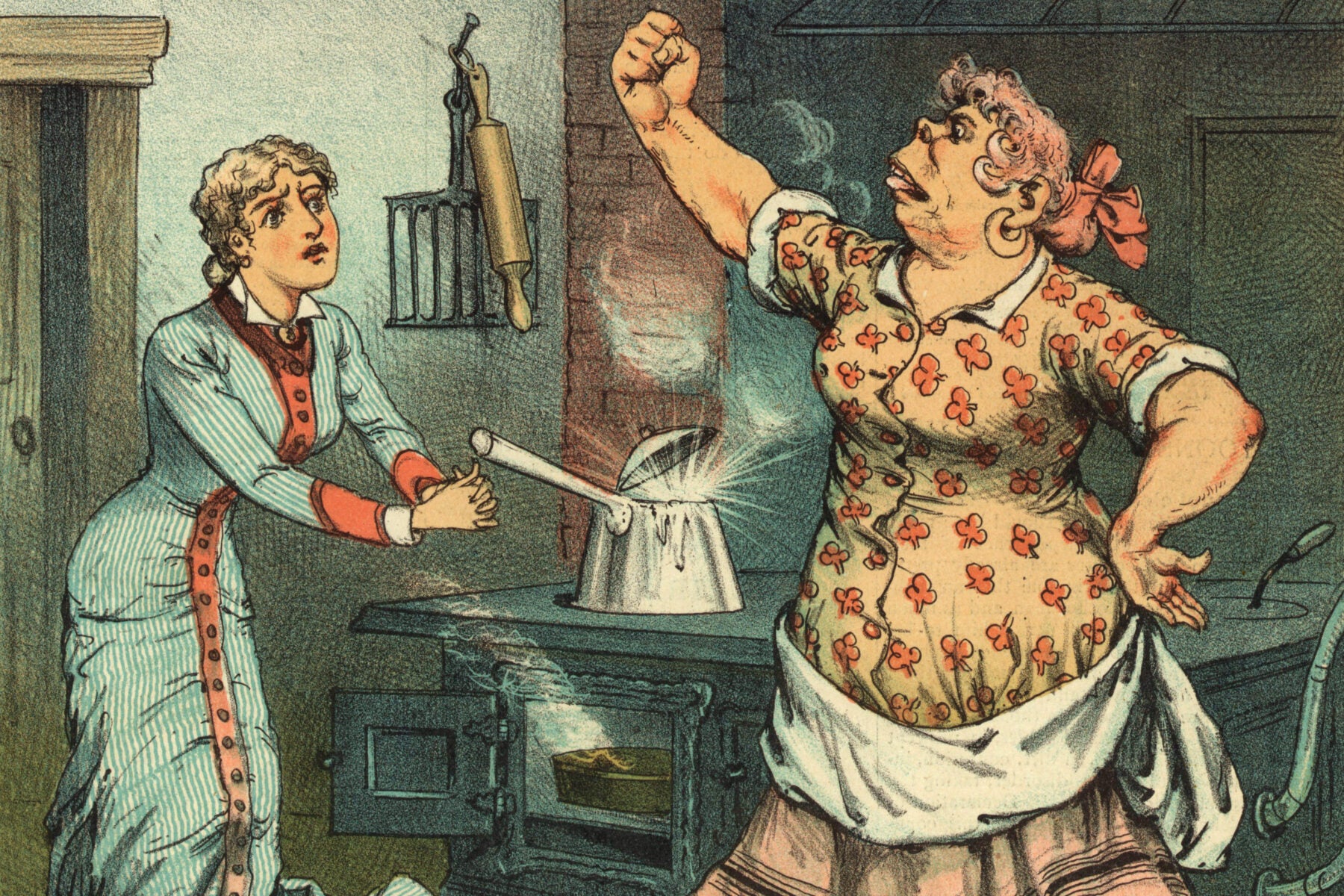From the 1840s onward a consistent stream of young, single women and girls flowed into in the United States from famine stricken Ireland. Many of these new arrivals were named Bridget for the beloved Irish Saint, Brigid. Many, too, went into domestic work once they got here. By the 1850s, roughly seventy-five percent of all women in domestic service jobs in New York City were Irish immigrants. By 1900, some sixty percent of all Irish-born women who had worked in America had done so in domestic service, as historian Hasia Diner points out in Erin’s Daughters in America. So many among this cohort were named Brigid or Bridget, in fact, that the name came to represent this entire population.
Before long, Bridget, or Biddy for short, became a caricature in women’s magazines of the nineteenth century, embodying exactly the opposite of the gentility and refinement possessed by the Victorian women who employed her. Where the Victorian ladies were demure and dainty, Biddy was rough and uncouth. Where they were efficient and well-mannered, she was lazy and prone to violent outbursts. Where they were measured and careful, she was clumsy, ever breaking crockery. Bridget, writes April Schultz in “The Black Mammy and the Irish Bridget: Domestic Service and the Representation of Race, 1830–1930,” was part of the “not-quite-white” Catholic immigrant population, which struck fear in the hearts of American Protestants. In “The Stage Irishwoman,” women’s studies scholar M. Alison Kibler further accentuates the nativist, anti-Catholic sentiment of the time, noting that “Irish Catholic servants were accused of being spies for the Pope and of baptizing Protestant babies while employers were away.”
In caricatures, as Christine Palumbo-DeSimone points out in “’Kitchen Queens’ and ‘Tributary Housekeepers’: Irish Servant Stories in Nineteenth-Century Women’s Magazine Fiction,” Bridget’s manner of speech was irreverent, and her prattle was frequently the subject of ridicule and imitation. In 1856’s “Trials of an English Housekeeper,” which appeared in the magazine Godey’s Lady’s Book, said housekeeper observes that her employer is “takin’ to the bottle,” upon being asked to provide a drink. In 1861’s “In Need of a Servant,” from Peterson’s Magazine, Bridget O’Mulligan evades the question of where she last worked with “the air…of an empress,” and notes, “Last, is it? Shure, and I’m not in the habit of having questions asked.” In 1891’s “How I Advertised for a Servant” a “toothless monster” is interviewed by a potential employer seeking an American-born maid. The Irish woman responds, “I’m an American born, an’ me father an’ hither before me. Shure, an’ its mesilf can do yer whurk like a charm.”
Weekly Newsletter
Bridget was also portrayed as simple and crass. “Cooks,” from 1852, tells of an Irish servant girl—“short, fat, vulgar-looking girl, with brown hair”—instructed to serve sausage with tea. In short order, her mistress is dismayed to discover the links literally within the tea pot. Periodicals also ran cartoons mocking her and her ludicrous missteps. An 1889 image in Harper’s Weekly shows Biddy flirting with a bowl of spuds, the caption reading, “The cook came in and mashed the potatoes.” In the parlance of the day, to mash meant to flirt.
Below the humorous depictions of Biddy lay the collective anxiety of her employers. Middle class women in the nineteenth century were supposed to be masters of their domestic sphere. As Palumbo-DeSimone points out, there was an impossible paradox in ceding control of their households to Bridget; middle class women were losing grasp on how to perform the domestic skills their mothers could execute. These women were suddenly at the mercy of Irish servants whom they deemed inferior. In Irish Stereotypes in Vaudeville, 1865–1905, Jennifer Mooney points out that Biddy—aggressive and therefore also viewed as masculine—was a “threat to the peace and order of the American home.” An anarchic force, she was seen as antithetical to a world governed by strict behavioral codes. Unmarried and independent, Biddy paid her own way in this new world, and as such served as a reminder to her employers that another way of life was possible—no doubt a threat to the status quo. Maintaining that status quo required dehumanizing Bridget; so doing would enable her employers to maintain their sense of superiority and dominance.
And so, Biddy caricatures were ubiquitous. Her blunders were shared in stereographic photographs, or picture stories such as “How Biddy Served the Tomatoes Undressed” and “Biddy Serves the Potatoes Undressed,” in which a servant bears bowls of food, while she bares nearly all of herself. Biddy was likely a common character on Vaudeville stages as well. The existence of “Leave me to sleep, Biddy,” a parody by the Vaudeville impresario Tony Pastor, suggests that she was a stock character on variety and concert saloon stages when Pastor performed. Lewd lyrics depict her as a desperate, sexually ravenous woman who won’t let her suitor sleep.
Drop down by the pig, here, and share his embrace,
Let my red whiskers lie close to your face;
The craythur won’t hurt you, he’ll do you no harm,
Lie down by me, Biddy, and keep my back warm:
Squeeze me up tight, as you’ve oft done before—
I’ll sing you to sleep wid the sound of my snore.
The rats and the mice all around us may creep—
So, leave me to sleep, Biddy, leave me to sleep.
From the mid-nineteenth century onward, the Biddy theatrical caricature flourished. In skits on stages around the country, she lifted her skirts high, fell down drunk, cavorted with men, set herself on fire, and otherwise died in easily preventable ways. Audiences flocked to laugh at Bridget’s depraved grotesquerie described in countless ditties and songs. Even Cole Porter, then an undergraduate at Yale, got in on the action with his 1910 song “Bridget,” whose lyrics assert, “Ah! You’re far too delicious to wash and wipe dishes//Miss Bridget, Bridget McGuire.”
In media, Biddy was a static stereotype, replicated for at least seventy years. She was sexual, yet repulsive, memorable, yet deplorable, female, yet violent. Most of all she was funny and had the makings of a permanent persona. (Indeed, though lanky and thin, Amelia Bedelia, the beloved children’s book character first introduced in 1963 is arguably a Biddy for the early elementary school set, a continuation of all the red-haired maids before her, forever and ludicrously misapprehending instructions).
That permanence was not assured; Bridget withstood efforts to cancel her, which began in the early 1900s, when members of the Irish community in the United States began to forcefully demand more respectful portrayals of their women. They did so, even while they sought greater political ends: the liberation of Ireland from Britain. The irony, argues historian Janet Nolan, is that the foundation of Ireland’s economic healing post-famine (An Gorta Mór, The Great Hunger, 1845–1852) came in part from remittances real-life Bridgets sent back to Ireland. Still, all the while they persisted in their objections to Biddy mockery. Some took to rioting in 1907 at Brooklyn’s Orpheum Theater, where protestors hurled eggs and lemons aiming for at the Vaudevillian Russell Brothers—John and James—in the middle of “the Irish Servant Girls,” their signature sketch ridiculing immigrants from Ireland.
Groups like the Clan na Gael, the Gaelic League, and the Ancient Order of Hibernians (both male and female factions) had been coming together to fight the stereotypes. In 1903, Clan na Gael members hissed during a production of McFadden’s Row of Flats at a theater in lower Manhattan. They escalated their efforts at a subsequent showing by throwing eggs. Similar protests took place in Philadelphia, though anger was not limited to the east coast. In Butte, Montana Irish audience members came armed to a staging of the Dreamland Burlesque, leading to its cancellation, and in Dublin, the Gaelic League planned an attack on a staging of The Playboy of The Western World by John Millington Synge. Indeed, a coalition of groups defending Irish identity soon came together, calling itself the Society for the Prevention of Ridiculous and Perversive Misrepresentation of the Irish Character. To be sure, it helped change how the Irish were depicted in media.
If playing Bridget on stage became an occupational hazard, playing her on screen became a safe alternative vehicle to deliver the same old joke. According to Peter Flynn, How Bridget Made the Fire, The Finish of Bridget McKeen, and Mary Jane’s Mishap—Or, Don’t Fool with Parafin, all produced in the first years of the twentieth century, follow the same script: Servant Bridget is struggling to light the stove. She pours a flammable substance onto the flames, fatally catching herself on fire. Her tombstone reads “Here Lies the Body of Bridget McKeen, who lighted the fire with kerosene,” or something of that ilk. Other reels show Bridget in violent outbursts toward her employer; flirting with police; and failing in her efforts to climb the social ladder. Still one more common storyline follows Bridget handling herself poorly after receiving an inheritance.
In our day, the persona of Bridget arguably endures in the comportment of Melissa McCarthy, the actor who first gained attention as Sookie St. James in the kitchen of the Independence Inn on Gilmore Girls, which ran on television from 2000 to 2007. A relative teetotaler, Sookie was nevertheless accident prone and improbably ushered Bridget into the twenty-first century.

McCarthy keeps up the caricature in film. Consider her portrayal of Diana in Identity Thief (2013). She wears a funny, frilly outfit under a mass of red curls, a modern incarnation of a Russell Brother, blundering through physical calamities that would kill anyone else. Her nemesis describes her as a hobbit, harkening to J.R.R. Tolkien’s invention of such creatures in The Lord of The Rings, (a work likewise haunted by racism).
In other films, McCarthy similarly employs an arsenal of Bridget tools: a robust bosom, ribald vernacular, a seeming invulnerability to pain, no nonsense brashness, unruliness, boisterous comedic physicality, and the ability to make viewers laugh in spite of themselves. These are hallmarks of the original Vaudeville Bridget. Yet McCarthy strips them of the overt, in-your-face Irishness that marked the Biddys of yore. Her appeal is largely grounded in what Camille Forbes describes as “the persistence of minstrelsy.”
Still, the overt stereotypes of the Vaudeville era have been softened. A character’s Irishness is more than likely expressed in subtle cues, such as the surname of a character like McCarthy’s Molly Flynn from TV’s Mike and Molly. McCarthy’s popularity has an every-woman quality that takes root in a less racialized Irishness. While she seems to inhabit a benign persona, the humor in her comedic roles is anchored in a racist and unsettling history.
Like past Bridgets, McCarthy’s characters often flirt with or pine after men in positions of authority: Molly’s Mike is a cop; Megan’s love interest in Bridesmaids is an air marshall; in Spy, Susan has a crush on a secret agent. Like past Bridgets, McCarthy’s characters make us laugh as they attempt to hoist themselves up the social ladder: in Identity Thief, Diana buys garish clothes; the title character in Tammy is ridiculed after a full makeover; Bridesmaids’ Megan returns to her slovenly habits after a foray in fancy attire; she eats a massive sub balanced on the chest of her boyfriend.
Like past Bridgets, McCarthy’s characters compensate for their lack in social graces with superhuman agility. Spy’s Susan may look like a full-figured desk clerk, but secretly she’s an expert in combat. Shannon in The Heat is a ferocious, almost animalistic cop, capable of chasing down criminals on foot. Megan introduces herself in Bridesmaids by regaling others with an account of how she fell off a cruise ship.
Through McCarthy, we laugh at Bridget without the moral guilt that may accompany the act of dehumanizing others. McCarthy is heavyset and hilariously bawdy, though not overtly Irish. Yet to discerning viewers, she is indisputably Biddy’s descendent.
Editor’s note: An earlier version of this article mistakenly described the television character Sookie St. James as frequently inebriated. In fact, she rarely drank alcohol.







